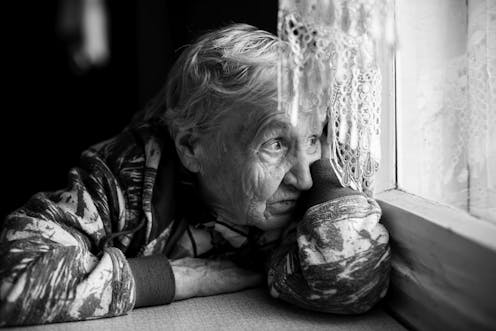Violence between residents in nursing homes can lead to death and demands our attention
- Written by Briony Murphy, PhD Candidate, Epidemiology & Forensic Medicine, Monash University
 Two high-level reports on elder abuse in aged care in Australia have recommended better reporting systems.from shutterstock.com
Two high-level reports on elder abuse in aged care in Australia have recommended better reporting systems.from shutterstock.comSome preventable deaths in nursing homes are a result of aggression between residents. This most commonly occurs in people with dementia, our new research has found.
Ours is the first study to examine the frequency and nature of resident-to-resident aggression resulting in the most severe outcome – death. In our analysis, almost 90% of residents involved in resident-to-resident aggression had a diagnosis of dementia. Three-quarters had a history of behavioural problems, including wandering and verbal and physical aggression, which are common symptoms of dementia.
Published in the Journal of the American Geriatrics Society today, we examined records for all resident-to-resident aggression-related deaths among nursing home residents reported to a coroner in Australia between 2000 and 2013.
We identified 28 deaths resulting from aggression between nursing home residents in Australia over the 14-year study period. This is within around 3,000 deaths that occurred from non-natural causes. However, due to reporting limitations, the number of deaths due to resident-to-resident aggression is likely to be the tip of the iceberg.
Read more: Many older people in care die prematurely, and not from natural causes
The rising global prevalence of dementia, particularly in the nursing home population, means aggressive behaviours between residents will increasingly be an issue. Two high-level reports on elder abuse in aged care in Australia have recommended better reporting systems so we can understand and prevent all such deaths in nursing homes.
Aggression in nursing homes
Resident-to-resident aggression is an umbrella term that includes physical, verbal or sexual interactions that are considered to be negative, aggressive or intrusive. These behaviours can cause serious physical harm or psychological distress.
The prevalence of aggression between nursing home residents is difficult to determine. Recent research estimates at least 20% of nursing home residents in the US were involved in such incidents.
These typically occur between residents with a cognitive impairment or diagnosis of dementia. A recent analysis of the international literature revealed physical forms of aggression between residents occurred most frequently in communal areas of the nursing home and during the afternoon. This is when the behavioural and psychological dementia symptoms usually manifest (also known as “sundowning”).
Most incidents appeared to be unprovoked, or were triggered by communication issues or a perceived invasion of personal space. Importantly, only one of the 18 studies reported a single death as the result of physical resident-to-resident aggression.
 Wandering is a common symptom of dementia.from shutterstock.com
Wandering is a common symptom of dementia.from shutterstock.comOur research found most exhibitors of aggression (85.7%) were male. The risk of death from aggression between residents was twice as high for male as for female residents. Those who exhibited aggression towards other residents were often younger and more recently admitted to the nursing home than their targets.
Incidents commonly involved a “push and fall”. Seven (25%) related deaths resulted in a coronial inquest, but criminal charges were rarely filed.
However, this is likely to be just the tip of the iceberg as there is much potential for underreporting and misclassification of resident-to-resident aggression deaths. We have limited data on how often incidents of aggression between residents in Australia occur but do not result in death.
Reporting aggression
Our limited data are primarily due to how our mandatory reporting framework is structured. The Aged Care Act 1997 and associated Accountability Principles 2014 require nursing home providers to report allegations or suspicions of abuse to the federal health department and police within 24 hours. These allegations include unlawful sexual contact, unreasonable use of force, or assault against care recipients.
According to the Productivity Commission’s annual report on government services, the Commonwealth Department of Health received 2,625 notifications of assaults in nursing homes in the 2014-15 financial year. This is around 1.1% of all residents receiving care during that period. The majority (84%) of these reports were for alleged or suspected unreasonable use of force.
Read more: What is elder abuse and why do we need a national inquiry into it?
However, the legislation includes a discretion for providers not to report incidents of resident-to-resident aggression if the alleged offender has a previously assessed cognitive impairment and a behaviour management plan has been put in place for the care recipient within 24 hours of receipt of the allegation or suspicion of assault.
This means that the most common types of resident-to-resident aggression incidents (those involving cognitively impaired residents) are never collated and publicly reported. So we have no way of knowing the scale and severity of the problem.
The annual report statistics are also limited to identifying only the number of incidents. They do not include an analysis of the relationship between the target and exhibitor of aggression. This means we don’t know how many of the incidents were between residents or between residents and staff.
Finally, no other contextual information on the incidents is available in the annual report statistics. This represents a significant gap in knowledge on resident-to-resident aggression. In-depth analysis of contributing factors can help provide evidence to inform prevention strategies.
Preventing aggression between residents
This issue has not gone unnoticed. In its June 2017 report on elder abuse, the Australian Law Reform Commission recommended that aged care legislation should provide for a new serious incident response scheme. The scheme would require approved providers to notify an independent oversight body of any allegation or suspicion of a serious incident in their facility.
In relation to resident-to-resident aggression, these notifications would include incidents of physical abuse causing serious injury, or incidents occurring as part of a pattern of abuse.
Read more: Elder abuse report ignores impact on people’s health
The federal government’s recent review of aged care regulation supported this recommendation. The review was initiated in response to revelations of abuse and neglect in South Australia’s Oakden Aged Mental Health Service.
Ensuring accurate reporting of incidents of aggression between residents, and raising community awareness of ageing-related issues, are important first steps to improve our aged care system and prevent harmful interactions between vulnerable older adults in care.
Briony Murphy is a member of the Victorian executive committee of the Australian Association of Gerontology.
Joseph Ibrahim received funding from the Commonwealth and State Health Department (Victoria) for this research. Joseph also has funding grants from Dementia Training Australia and Victorian Managed Insurance Authority.
Authors: Briony Murphy, PhD Candidate, Epidemiology & Forensic Medicine, Monash University





